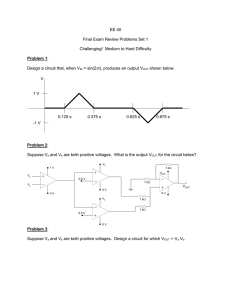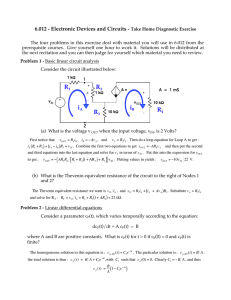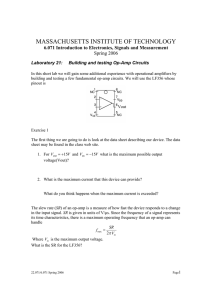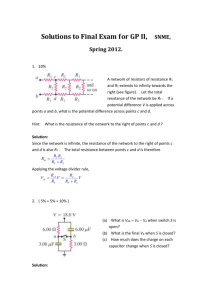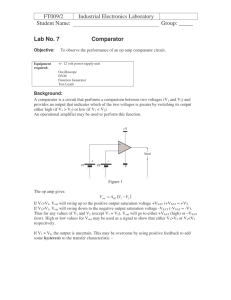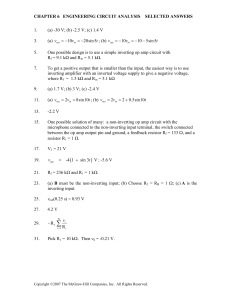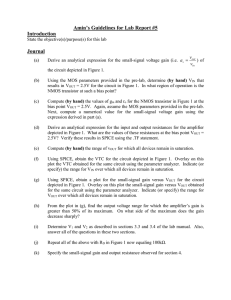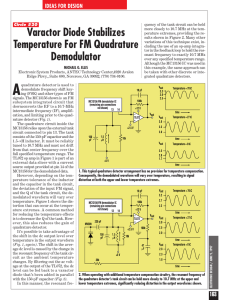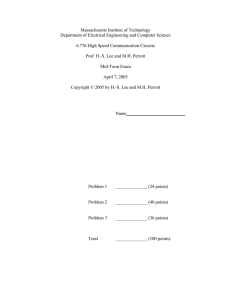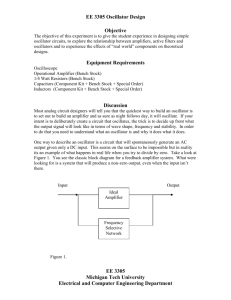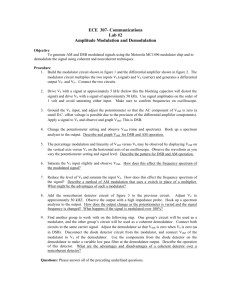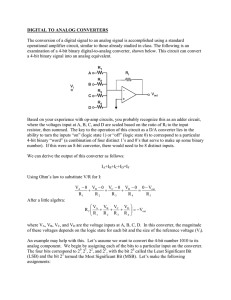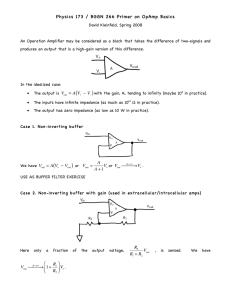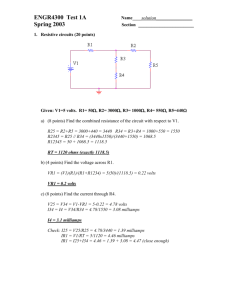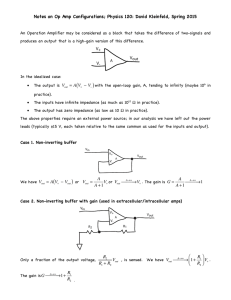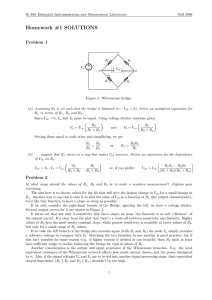Final_MATH-Solutions
advertisement
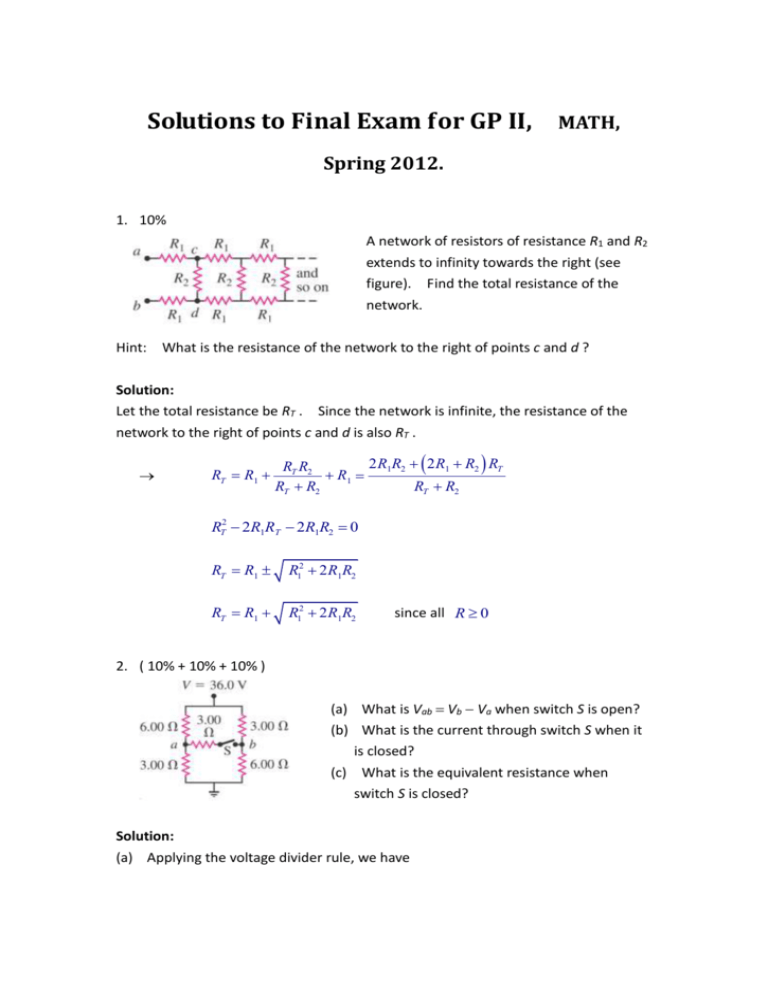
Solutions to Final Exam for GP II, MATH, Spring 2012. 1. 10% A network of resistors of resistance R1 and R2 extends to infinity towards the right (see figure). Find the total resistance of the network. Hint: What is the resistance of the network to the right of points c and d ? Solution: Let the total resistance be RT . Since the network is infinite, the resistance of the network to the right of points c and d is also RT . RT R1 2 R1R2 2 R1 R2 RT RT R2 R1 RT R2 RT R2 RT2 2R1RT 2R1R2 0 RT R1 R12 2 R1R2 RT R1 R12 2 R1R2 since all R 0 2. ( 10% + 10% + 10% ) (a) What is Vab Vb Va when switch S is open? (b) What is the current through switch S when it is closed? (c) What is the equivalent resistance when switch S is closed? Solution: (a) Applying the voltage divider rule, we have Va 3 36 V 12 V 6 3 Vb 6 36 V 24 V 3 6 Vab 24 V 12 V 12 V (b) For the upper loop: 6 I 1 3I 3I 2 0 For the lower loop: 3 I I 1 3I 6 I I 2 0 For the left leg: 6I 1 3 I1 I 36 For the left leg: 6I 1 3 I1 I 36 Simplifying gives 2I 1 I I2 0 I1 4 I 2 I 2 0 3I 1 I 12 1st 2 eqs gives 3I 1 6 I 0 or Current through S is (c) 1 12 24 I 1 12 A 3 7 7 I 1 2I 0 I 12 A 7 I2 2 24 12 36 A 7 7 7 R Equivalent resistance: V 36 21 I1 I 2 24 36 5 7 7 3. ( 5% + 10% ) A long, straight, solid cylinder, oriented with its axis in the z-direction, carries a current density J given by 2 I r 2 02 1 kˆ J a a 0 for r a for r a where a is the radius of the cylinder, r is the radial distance from the axis, and I0 is a constant. (a) Show that I0 is the total current. (b) Find the magnetic field inside and outside the cylinder. Solution: (a) Total current = 2 a 0 (b) Ampere’s law C 2I0 a2 r 2 4I0 1 2 1 1 4 1 r d r 2 a 2 a I 0 a 2 a 4 a B d r 0 I . To calculate the field at a pointof distance r from the axis, choose C to be a circle of radius r , centered on the axis and passing through that point. Then I B 0 enclosed 2 r For r < a, the enclosed current is I 2 r 0 2I0 a2 4I 20 a B r 2 1 r d r a 2 2 1 2 1 1 4 r r 2 r a 2 4 r I 0 a 2 a 0 I 0 I 0 r r 2 2 r 2 a 2 a 2 For r > a, the enclosed current is I0 . I B 0 0 2 r 4. ( 15% + 10% ) Figure shows a small circuit within a larger one, both lying on the surface of a table. The switch is closed at t = 0 with the capacitor initially uncharged. Assume that the small circuit has no appreciable effect on the large one. (a) What is the direction ( a to b or b to a ) of the current in the resistor r i. The instance after the switch is closed? ii. One time constant after the switch is closed? (b) Sketch a graph of the current in the small circuit as a function of time, calling clockwise as positive. Solution: (a) i. The instance after S is closed, I in the large circuit goes CCW to charge C. This creates B pointing out of the paper. Magnetic flux through the small circuit thus jumps from 0 to a finite value, thus producing a negative emf so that the current in r goes CW (from a to b). ii. One time constant after S is closed, I in the large circuit decreases exponentially towards 0 as C becomes more charged. through small circuit thus decreases with time, producing a positive emf so that the current in r goes CCW (from b to a). (b) 5. 20% Vs in the figure is a signal source. Derive an expression for the amplitude ratio Vout / Vs as a function of the angular frequency of the source. Find the limits for 0 and Solution: Vs Q dI L IR 0 C dt For a sinusoidal signal of frequency , I Vs i LI I R 0 iC Voltage divider: 1 Vout iC Vs 1 R i L C Amplitude ratio: 1 Vout Vs 1 iC 2 1 R i L C R2 1 L C C 1 C R 2 For 0, Vout 1. Vs For , Vout 0. Vs 1 2 LC 2 .

